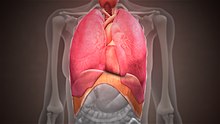
Back Middelrif Afrikaans Zwerchfell ALS حجاب حاجز Arabic ܚܠܒܐ (ܝܘܠܦܢ ܨܪܘܝܘܬܐ) ARC Diafraqma (anatomiya) Azerbaijani Дыяфрагма (анатомія) Byelorussian Залона BE-X-OLD Диафрагма (анатомия) Bulgarian মধ্যচ্ছদা Bengali/Bangla Kelc'hspeurenn Breton
| Diaphragm | |
|---|---|
 Respiratory system | |
| Details | |
| Origin | Septum transversum, pleuroperitoneal folds, body wall[1] |
| Artery | Pericardiacophrenic artery, musculophrenic artery, inferior phrenic arteries |
| Vein | Superior phrenic vein, inferior phrenic vein |
| Nerve | Phrenic and lower intercostal nerves |
| Identifiers | |
| Latin | diaphragma |
| Greek | διάφραγμα |
| MeSH | D003964 |
| TA98 | A04.4.02.001 |
| TA2 | 2327 |
| FMA | 13295 |
| Anatomical terms of muscle | |

The thoracic diaphragm, or simply the diaphragm (/ˈdaɪəfræm/;[2] Ancient Greek: διάφραγμα, romanized: diáphragma, lit. 'partition'), is a sheet of internal skeletal muscle[3] in humans and other mammals that extends across the bottom of the thoracic cavity. The diaphragm is the most important muscle of respiration,[4] and separates the thoracic cavity, containing the heart and lungs, from the abdominal cavity: as the diaphragm contracts, the volume of the thoracic cavity increases, creating a negative pressure there, which draws air into the lungs.[5] Its high oxygen consumption is noted by the many mitochondria and capillaries present; more than in any other skeletal muscle.[4]
The term diaphragm in anatomy, created by Gerard of Cremona,[6] can refer to other flat structures such as the urogenital diaphragm or pelvic diaphragm, but "the diaphragm" generally refers to the thoracic diaphragm. In humans, the diaphragm is slightly asymmetric—its right half is higher up (superior) to the left half, since the large liver rests beneath the right half of the diaphragm. There is also speculation that the diaphragm is lower on the other side due to heart's presence.
Other mammals have diaphragms, and other vertebrates such as amphibians and reptiles have diaphragm-like structures, but important details of the anatomy may vary, such as the position of the lungs in the thoracic cavity.
- ^ mslimb-012—Embryo Images at University of North Carolina
- ^ "Definition of 'diaphragm'". collinsdictionary.com.
- ^ Campbell NA (2009). Biology: Australian Version (8th ed.). Sydney: Pearson/Benjamin Cumings. p. 334. ISBN 978-1-4425-0221-5.
- ^ a b Spencer's pathology of the lung (5th ed.). New York: McGraw-Hill. 1996. p. 1. ISBN 0071054480.
- ^ "Medical Illustrations and Animations, Health and Science Stock Images and Videos, Royalty Free Licensing at Alila Medical Media". www.alilamedicalmedia.com.[full citation needed]
- ^ Arráez-Aybar LA, Bueno-López JL, Raio N (March 2015). "Toledo School of Translators and their influence on anatomical terminology". Annals of Anatomy - Anatomischer Anzeiger. 198: 21–33. doi:10.1016/j.aanat.2014.12.003. PMID 25667112.
© MMXXIII Rich X Search. We shall prevail. All rights reserved. Rich X Search